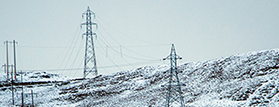Big winter snowstorms can cause a lot of havoc, from dangerous, icy roadways to frozen water pipes. Power outages are also a big risk during a blizzard or heavy snowfall, and these blackouts can put a lot of stress on municipalities. Here are some of the common reasons why power goes out during snowstorms and what can be done to prevent it.
How Snow and Ice Impact Power Lines
In the winter, two of the biggest dangers to power lines are snow and ice. While a little bit of snow might not cause too many problems, a big snow dump can start to weigh down trees and even power lines. Ice is even more dangerous, as it can become quite heavy. Ice and snow together could be the straw that breaks the camel’s back, causing large tree limbs to fall or roofs to collapse.
Downed tree branches can land on power lines, taking out electricity for large swaths of customers.
Ice in and of itself poses a great risk to power lines since it is so heavy. Ice can short out power lines and completely take them down with just one inch of precipitation.
Local distribution lines, especially the ones that transport power in rural areas, are typically the most at risk. These lines are usually much more vulnerable because these areas are much less likely to engage in regular tree pruning and maintenance. Long-distance high voltage power lines usually fare better due to ongoing tree maintenance but can still be vulnerable to heavy ice storms.
Why Extremely Cold Temperatures Cause Power Outages
Even if the power lines stay up, extremely cold weather can put a tremendous amount of stress on the power grid. Some electrical system components may fail since they simply can’t handle the colder temperatures.
Excess cold means more people will be turning up the heat, which can add to the load on the electric grid. In the devastating deep freeze that hit Texas in February of 2021, rolling power outages were implemented to try to alleviate grid strain. The deadly winter storm took almost 250 lives according to the state of Texas, with 161 of those related to extreme cold exposure.
These types of tragic deaths can hopefully be prevented in the future through better planning as well as improved technologies.
Winter Wind Poses a Danger to Power Lines
2021 wasn’t just a bad year for cold weather, it was a year in which we saw a lot of December tornados. And while you don’t normally get a tornado with snow, blizzards can often come blustering in via strong winds. These winds can impact power lines directly and indirectly through falling tree limbs.
Animals Can Also Damage Power Lines in the Winter
Both land- and air-based animals can threaten power lines and cause power outages. Birds can unfortunately fly into power lines and squirrels have a habit of chewing on things. Some animals may also try to take shelter in or near equipment like transformers during the winter due to the heat emitted. They may end up damaging the equipment in the process.
> Birds are vulnerable to electrocution by power lines, and they are more vulnerable when wet. If you ever wondered why birds can sit on power lines, it’s simply because they have two feet on the same wire, so the electricity doesn’t need to travel through the bird. But if the bird accidentally touches a different wire or another part of the same wire with a wing, the electrical polarity changes and the bird can get zapped.
Flying into power lines is the bigger problem and kills tens of millions of birds each year. High voltage power lines (as opposed to distribution power lines) create the biggest threat to birds. The electricity being delivered is so strong, it ionizes the air and causes a voltage gradient that gets stronger the closer you get to it. Birds can usually sense this electricity in the air and will steer clear … unless they are flying too fast. In this case, a bird can be literally electrocuted in the air by the voltage gradient without even touching a wire. If they do end up crashing into a line, they can cause a lot of damage.
Preventing Power Outages in the Winter
Utility companies can take some proactive actions to reduce winter power outages. Properly maintained power lines will be less likely to fail during a storm. Keeping trees and debris cleared away from lines and equipment is also essential. Routine equipment inspections should be a key part of every winter storm plan. As for animals and pests, some of these incidences cannot be prevented but a variety of anti-pest and animal protection measures can potentially help, such as perch deterrents.
Keep the power on during the winter with professional vegetation management from Townsend Tree, a reliable provider of tree trimming and debris clearing for utilities, local governments and energy companies. Contact us today to find out how we can keep your energy systems working during the winter.
